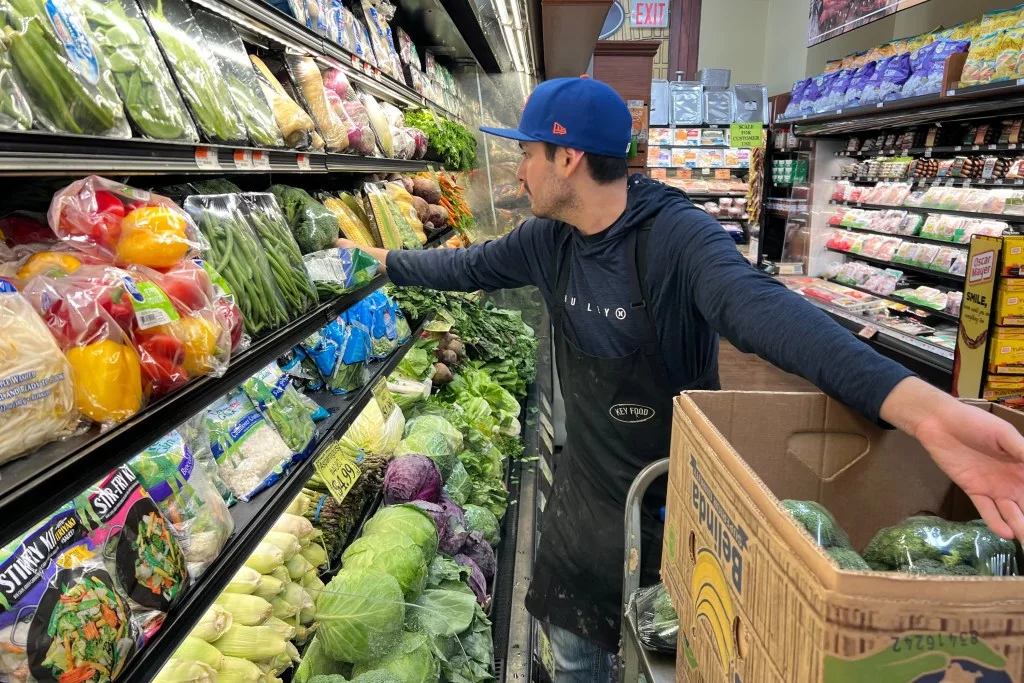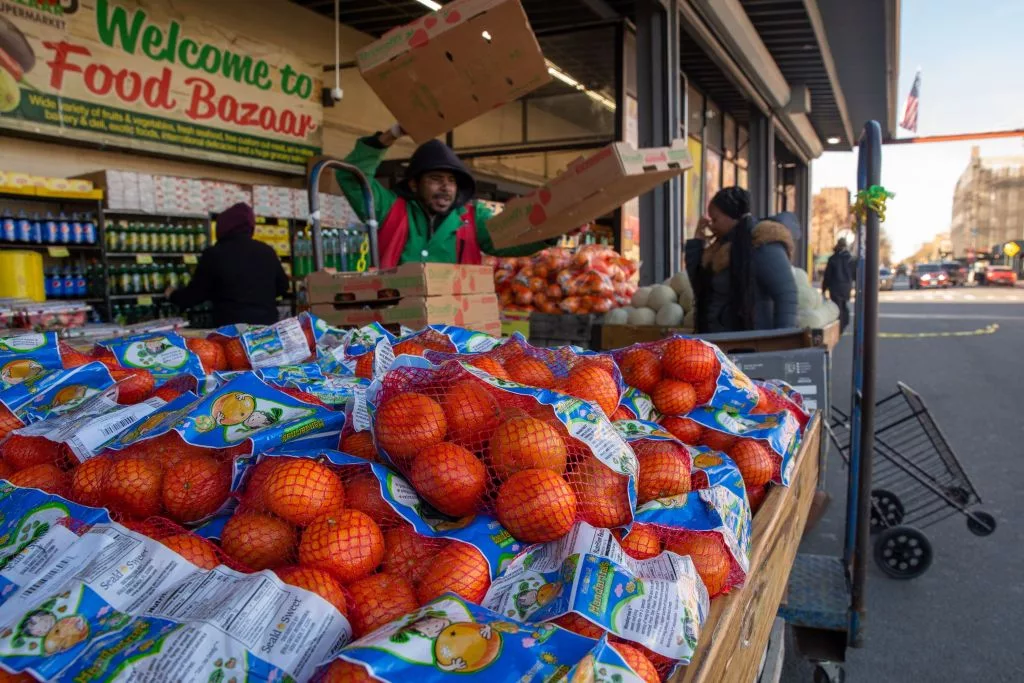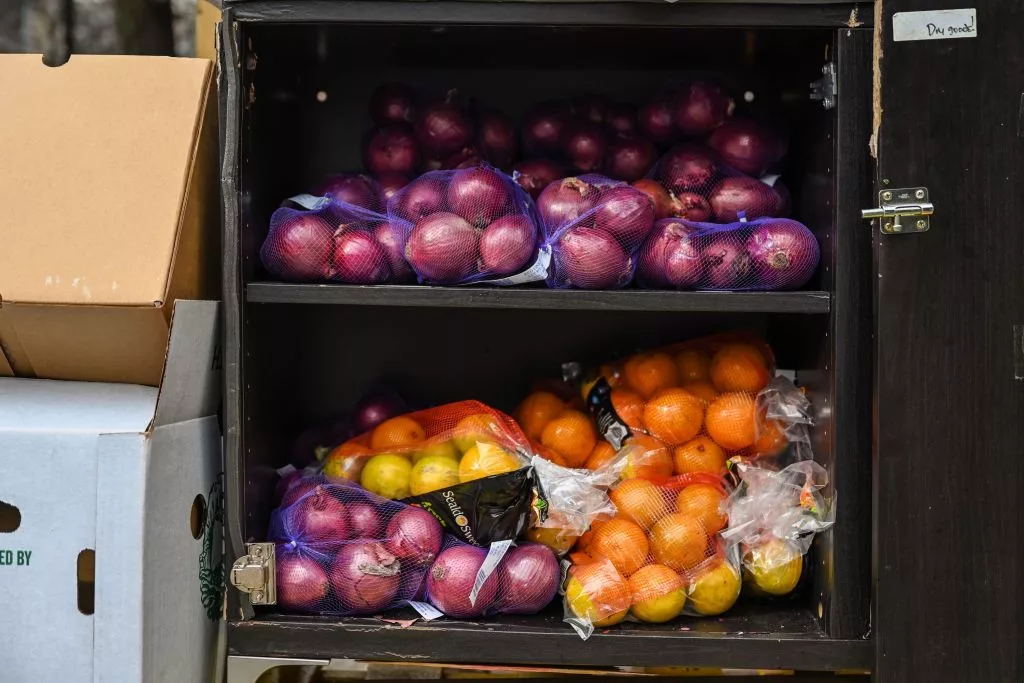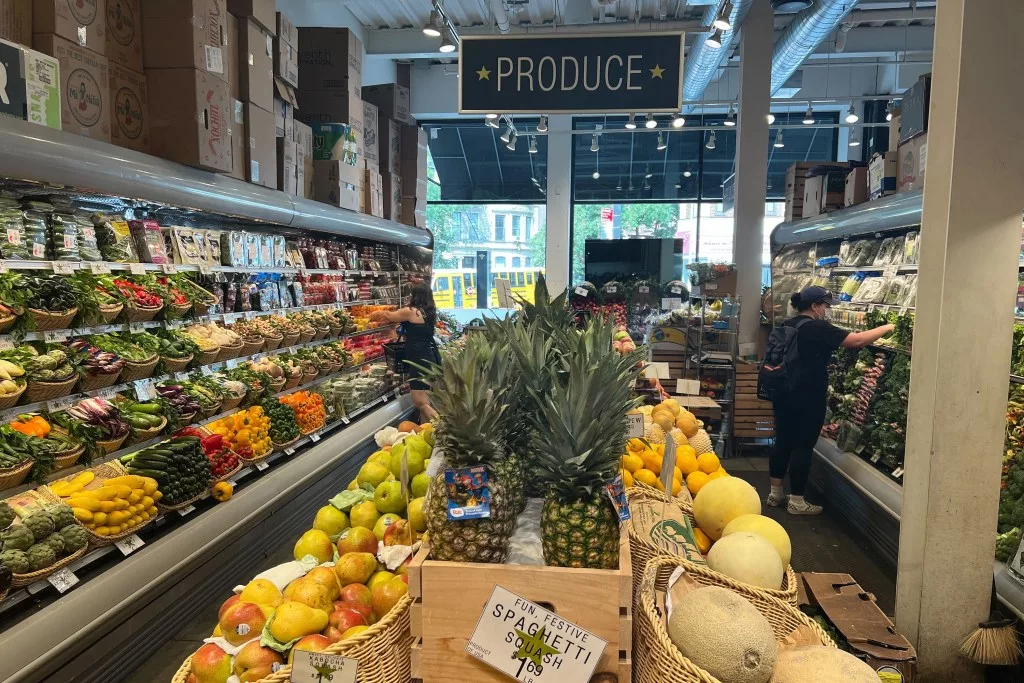This story was originally published by THE CITY. Sign up to get the latest New York City news delivered to you each morning.
If you’re a New Yorker having a hard time putting food on the table, you’re not alone — and more people qualify for help than you may think.
In the last twelve months, one out of every four New Yorkers reported being food insecure, meaning they had limited or uncertain access to adequate nutrition.
In New York City, the largest benefit program to help food insecure people is the Supplemental Nutrition Assistance Program (SNAP), formerly called and still often referred to as food stamps. About 1.8 million people receive benefits through SNAP in the city. SNAP is funded by the federal government but is administered by the county, or in our case, New York City.
This summer, for the first time, New York and several other states are participating in the Summer EBT program, providing low-income families with school-age children additional food benefits over the months where many students are out of school (more on this later).
Despite the overwhelming need for food assistance in New York City, advocates say that the stigma and shame around receiving food benefits stop would-be eligible people from even applying.
Here’s our guide on SNAP benefits, with some information about other food programs, to make the application process easier:
Jump to …
- Am I qualified for food benefits?
- Names to know: What are the main food benefits programs?
- Where can I get food with my EBT card?
- What can I buy with SNAP benefits?
- What can I not buy with SNAP Benefits?
- I’m undocumented. Am I eligible?
- If I apply for food benefits while also applying for U.S. citizenship or residency, does that put my immigration application at risk?
- If I receive benefits, will that take a spot away from someone else?
- How do I apply?
- What documents do I need to apply for SNAP?
- Can I get help with the application?
- Will I need to give an interview to get benefits?
- What do I do if my application is denied?
- I’m hungry now. Where can I go?
Am I qualified for food benefits?
Lots of low- or moderate-income people may be eligible, even if they feel like they aren’t struggling enough to apply for help. Earning money, owning a house, having a bank account or private health insurance do not disqualify you from applying for SNAP.
New York City has an online screener tool in a few different languages you can use to check your eligibility for different social services in the city. That tool is not the same as an application, but it can give you an idea of whether or not you qualify. If the tool shows that you’re eligible, your next step is to start the official application process.
Food benefit nonprofit organizations, including Hunger Solutions NY and Benefits Kitchen, have also created their own tools to check benefit eligibility.
The specific income guidelines to determine who is eligible for SNAP are calculated based on a lot of factors including the size of your household, your income and your expenses, making it hard to say what the magic number may be to get you into the program.
The guidance from the HRA is that if you need help buying food, you should apply.
Names to know: What are the main food benefits programs?
EBT: Electronic Benefit Transfer
EBT refers to the system and the physical card that lets recipients transfer their food benefits — like SNAP — to a retailer’s account, like with a debit card. There are restrictions for what you can buy with an EBT card (more on that later).
Also Read: How To Report Stolen SNAP Benefits and Claim Reimbursement
CSFP: Commodity Supplemental Food Program
CSFP is a nutrition benefits program intended specifically for seniors 60 and older who fall below a certain income. Once a month, you or someone representing you can pick up a food package at a CSFP distribution site. Through the program, you can also be connected to nutritionists who can give cooking demonstrations and nutrition lessons. Notably, you can get CSFP even if you are also receiving SNAP benefits. You can apply either by phone or in personat a CSFP site.
SNAP: Supplemental Nutrition Assistance Program
Formerly known as food stamps, SNAP is the federal program that provides nutritional benefits to low-income individuals and families that are then used at stores to purchase food. Only people with a U.S. Social Security number are eligible for SNAP (more on that later).
Summer EBT
Though EBT by itself refers to the card and not the benefits program, there is a new program called Summer EBT. (Heads up: You may see the federal government refer to Summer EBT as Sun Bucks.) Through this program, any child who received SNAP benefits or who is eligible for a free or reduced price school lunch will receive an additional $120 on their SNAP EBT card. Most eligible children receive the benefits automatically, according to New York Office of Temporary and Disability Assistance, but other families will need to apply. If you’re unsure, check out their website. In 2024, the program is open between July 2 and September 3.
TANF: Temporary Aid to Needy Families
TANF is a federally funded cash-assistance program. It is not a nutrition-specific benefit, but cash of course can be used to buy food. In this guide, we won’t talk much about TANF — which, like SNAP, is only available to people with a U.S. Social Security number — but you can learn more and check out eligibility factors here.
WIC: Special Supplemental Nutrition Program for Women, Infants, and Children
WIC is the federal program specifically to help low income families with young children pay for food and groceries. While only U.S. citizens or permanent residents are eligible for SNAP, other noncitizens are eligible for WIC. WIC does not use the same EBT card as SNAP or TANF, but has its own card called the eWIC.
Where can I get food with my EBT card?
The Department of Agriculture has a SNAP Retailer Locator tool that will show you stores that accept EBT payments. While there’s no mandate for private businesses to accept EBT cards, thousands of places in New York City do so, including large grocery stores, pharmacies, bodegas and specialty food markets. There are also many online retailers that accept EBT payments, such as Amazon, ShopRite and Walmart. However, SNAP benefits cannot be used for delivery fees.

There are also many farmer’s markets across the city that accept SNAP benefits, including all GrowNYC Greenmarket and Farmstand locations. At these locations, SNAP recipients will visit the market information tent to swipe their EBT card in exchange for wooden tokens that can be spent at the market. Sometimes, farmers themselves may accept SNAP/EBT directly. In the city, SNAP recipients can also receive Health Bucks, $2 coupons for every $2 spent at a farmers market using SNAP on an EBT card, for up to $10 a day.
What can I buy with SNAP benefits?
The rules can be strict when it comes to what purchases are eligible for SNAP benefits. Here is what is allowed:
- Food and food products.
- Snack foods.
- Seeds to grow vegetables and plants that provide food, such as basil or tomatoes.
- Baby formula, foods for diabetic people, and diet foods.
- Spices, herbs, pectin, shortening and other edible items used for cooking.
- Water and ice labeled for human consumption.
What can I not buy with SNAP Benefits?
The general guidance is that you cannot buy anything inedible to humans, anything prepared or hot or any sort of controlled substance. That means no
- Prepared hot foods in any food stores.
- Any prepared food (hot or cold) meant to be eaten at a store or restaurant.
- Alcoholic beverages or tobacco.
- Cleaning products, paper products, toiletries, or cooking utensils.
- Pet supplies.
- Food preservation items like canning jars, freezer containers, or food-wrapping paper.
- Medicines, vitamins or minerals.
- Gardening items like fertilizer or peat moss.

I’m undocumented. Am I eligible?
It depends. Though only individuals with Social Security Numbers are able to receive SNAP benefits, you can still apply for members of your household with Social Security Numbers. For example, if you are a parent who is undocumented but your children are U.S. citizens, you can apply for SNAP on behalf of your children. There are also other eligible noncitizen groups who can qualify for SNAP benefits, but the distinctions are complicated.
If you’re unsure about your eligibility, you have a few options. You can visit or call a SNAP center in any of the five boroughs, an authorized community-based organization that works with the city on things like SNAP benefits, or your local state assembly member. There is no penalty for applying.
If you are staying at a hotel under the city’s 28-day voucher program, you may be eligible for a prepaid debit card program that will allow you to buy food and baby supplies using the card. To learn if you’re eligible, speak to the administrators at your shelter.
If I apply for food benefits while also applying for U.S. citizenship or residency, does that put my immigration application at risk?
No, but keep an eye on politics.
During the Trump administration, the Department of Homeland Security changed the long-standing rules on what qualifies for someone to be a “public charge,” or a person dependent on the state for resources. That meant that people applying for permanent residency or citizenship could potentially be penalized for receiving public benefits such as health insurance or food benefits.
At the end of 2022, the Biden administration changed the rules back so that using non-cash programs such as SNAP and Medicaid cannot be counted in public charge determinations. Unless a different administration makes a different ruling that returns nutritional benefits to public charge determinations, applying or receiving SNAP should not impact any immigration cases you are part of.
If I receive benefits, will that take a spot away from someone else?
No, there is no cap on how many people can participate in SNAP benefits, and your participation does not stop anyone else from applying or receiving the benefit.
According to Denise Fernandez, the benefits access director at Hunger Free America, some of the biggest barriers to receiving food benefits are often the negative feelings associated with needing to ask for help. Fernandez’s team often works with people for a long time before they start and then submit an application.
“There’s a human aspect to helping people who are finding themselves during one of the worst times in their lives,” said Fernandez. “You might have to reassure them one or two or three times or re-educate them on the processes.”

How do I apply?
You have a few options:
- AccessHRA website or mobile app.
- By applying online or on the app, you are able to upload all necessary documents into one place and track the process.
- Print out the form and mail it back to the following address:
- Supplemental Nutrition Assistance Program
PO BOX 29008
Brooklyn, NY 11202 - Return it to your local SNAP Center
- Supplemental Nutrition Assistance Program
- Community-based organizations can help you, especially if language or technology is an issue.
What documents do I need to apply for SNAP?
Potentially, a lot of them. These are the main categories of documents:
- Proof of Identity
- Examples: Driver’s license, U.S. passport, voter registration card, birth certificate
- Proof of where you live
- Examples: Current lease, current rent receipt with your name and address, letter from your landlord, mortgage records
- Proof of income (if any)
- Examples: Paystubs, letter from employer, recent tax return.
- Proof of current immigration status
- Examples: U.S. passport, green card, stamped visa
There are potentially many, many more documents you’ll need, depending on your particular situation. For a complete list of all eligible documents, see HRA’s SNAP document guide here.
Can I get help with the application?
Yes, HRA centers and a handful of community-based organizations are trained and certified as SNAP outreach providers and can walk you through the application process. This may be especially helpful if you are a person with disabilities, if English is not your first language, or if you generally have questions about the process and would like to work with someone who is familiar with its complications.
Will I need to give an interview to get benefits?
Yes, to get SNAP benefits, you will have to interview with a staffer from the Human Resources Administration, either over the phone or in-person.
The interview is meant to determine your eligibility for SNAP and to confirm you have the correct documents, or ask for additional information. Fernandez from Hunger Free America has a few tips to make the interview process as seamless as possible:
- Schedule the interview for a time you can be uninterrupted, if possible, to keep the environment as calm and stress-free as possible.
- Keep a copy of your application and all of the documents you submitted next to you while you do the interview so that you can easily reference and double-check the information you submitted and be sure you submitted your complete documentation.
- Be patient. The process can be tedious and you may feel like you’re being asked the same questions over and over again, but anxiety and frustration can make the process run longer.

What do I do if my application is denied?
If your application is denied, you should receive a written notice in the mail as to why within 30 days of your completed application. If the issue is with your documentation, you can resubmit an application at any time. If the HRA office has determined you are ineligible for SNAP benefits, you can turn to your local representatives or a community based organization to see if there are any other programs you may qualify for instead. For example, according to Fernandez, WIC is an underutilized program that many caregivers who are ineligible for SNAP may qualify for.
I’m hungry now. Where can I go?
Hunger Free America runs both a National Hunger hotline that you can call to talk to a representative and help you find food, as well as an online Find Food database, where you can type in your address and find local soup kitchens and food pantries.
Food Bank For New York City also has a map of food pantries, soup kitchens, mobile panties, senior centers, and mobile soup kitchens. Local mutual aid groups may also have food support and cash dispersal programs to help with groceries or fresh meals.
Do you have a story or a question about accessing food benefits? What else should we know about? Get in touch with THE CITY newsroom at ask@thecity.nyc.
THE CITY is a nonprofit newsroom that serves the people of New York. Sign up for our SCOOP newsletter and get exclusive stories, helpful tips, a guide to low-cost events, and everything you need to know to be a well-informed New Yorker. DONATE to THE CITY










